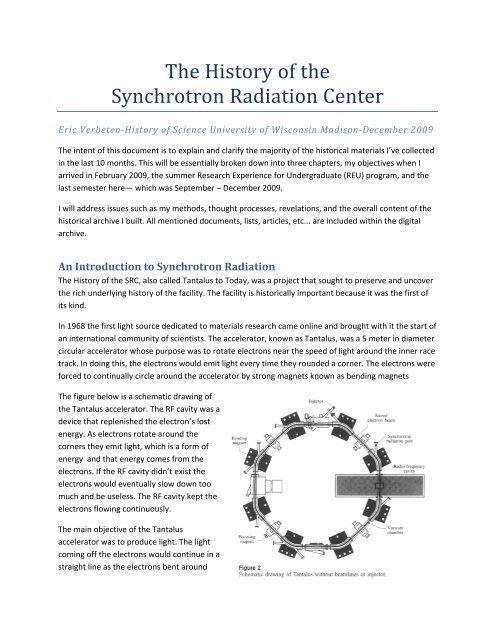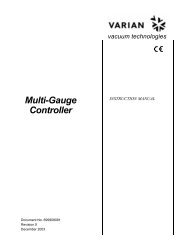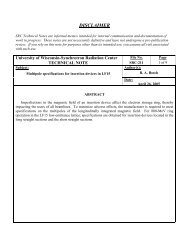here - Synchrotron Radiation Center - University of Wisconsin ...
here - Synchrotron Radiation Center - University of Wisconsin ...
here - Synchrotron Radiation Center - University of Wisconsin ...
You also want an ePaper? Increase the reach of your titles
YUMPU automatically turns print PDFs into web optimized ePapers that Google loves.
The History <strong>of</strong> the<br />
<strong>Synchrotron</strong> <strong>Radiation</strong> <strong>Center</strong><br />
Eric Verbeten‐History <strong>of</strong> Science <strong>University</strong> <strong>of</strong> <strong>Wisconsin</strong> Madison‐December 2009<br />
The intent <strong>of</strong> this document is to explain and clarify the majority <strong>of</strong> the historical materials I’ve collected<br />
in the last 10 months. This will be essentially broken down into three chapters, my objectives when I<br />
arrived in February 2009, the summer Research Experience for Undergraduate (REU) program, and the<br />
last semester <strong>here</strong>— which was September – December 2009.<br />
I will address issues such as my methods, thought processes, revelations, and the overall content <strong>of</strong> the<br />
historical archive I built. All mentioned documents, lists, articles, etc... are included within the digital<br />
archive.<br />
An Introduction to <strong>Synchrotron</strong> <strong>Radiation</strong><br />
The History <strong>of</strong> the SRC, also called Tantalus to Today, was a project that sought to preserve and uncover<br />
the rich underlying history <strong>of</strong> the facility. The facility is historically important because it was the first <strong>of</strong><br />
its kind.<br />
In 1968 the first light source dedicated to materials research came online and brought with it the start <strong>of</strong><br />
an international community <strong>of</strong> scientists. The accelerator, known as Tantalus, was a 5 meter in diameter<br />
circular accelerator whose purpose was to rotate electrons near the speed <strong>of</strong> light around the inner race<br />
track. In doing this, the electrons would emit light every time they rounded a corner. The electrons were<br />
forced to continually circle around the accelerator by strong magnets known as bending magnets<br />
The figure below is a schematic drawing <strong>of</strong><br />
the Tantalus accelerator. The RF cavity was a<br />
device that replenished the electron’s lost<br />
energy. As electrons rotate around the<br />
corners they emit light, which is a form <strong>of</strong><br />
energy and that energy comes from the<br />
electrons. If the RF cavity didn’t exist the<br />
electrons would eventually slow down too<br />
much and be useless. The RF cavity kept the<br />
electrons flowing continuously.<br />
The main objective <strong>of</strong> the Tantalus<br />
accelerator was to produce light. The light<br />
coming <strong>of</strong>f the electrons would continue in a<br />
straight line as the electrons bent around
the corner for another pass. That light was collected by long tubes called beamlines that connected to<br />
the <strong>Synchrotron</strong> <strong>Radiation</strong> ports as seen in the figure. The light was then modified and manipulated and<br />
shined on material samples at the end <strong>of</strong> the beamline. This process acts like a microscope and tells the<br />
scientist a lot about the material they are illuminating.<br />
The Tantalus Facility<br />
Although the phenomenon <strong>of</strong> synchrotron radiation had been known about since the 1940’s when at a<br />
lab at General Electric (GE) an accelerator t<strong>here</strong> demonstrated the event that electrons emit brilliant<br />
light when they are spun around near the speed <strong>of</strong> light. Since then accelerator physicists considered<br />
synchrotron light to be wasteful because that meant you had to re‐supply your spinning particles with<br />
more energy to keep their momentum. The Tantalus facility was different because their intention was to<br />
use that “waste” in order to understand how matter behaves and its structure. The Tantalus facility ran<br />
from 1968 through 1995 when it was finally decommissioned and disassembled for permanent storage<br />
at the Smithsonian Institute. However, in 1984 construction on a newer and much larger accelerator<br />
known as Aladdin began and succeeded the smaller Tantalus ring. The Aladdin accelerator is a bigger<br />
and more advanced version <strong>of</strong> the Tantalus ring and it sits similarly in an underground bunker‐like vault<br />
within a building named The <strong>Synchrotron</strong> <strong>Radiation</strong> <strong>Center</strong><br />
Preserving that History<br />
The two main objectives <strong>of</strong> the project were to conduct oral history interviews with the physicists who<br />
were a part <strong>of</strong> either <strong>of</strong> the facility’s two chapters, the Tantalus era and the Aladdin era. The second<br />
objective was to compile an archive full <strong>of</strong> documents that tell the story <strong>of</strong> the facility as a whole. These<br />
documents were scattered all around Kegonsa Research Campus (KRC) and they needed to be<br />
centralized. The KRC is made up <strong>of</strong> three primary buildings, the SRC, the old Tantalus building across the<br />
street and the Physical Sciences Laboratory (PSL) which is located next to the SRC. PSL is an organization<br />
with the <strong>University</strong> <strong>of</strong> <strong>Wisconsin</strong> Madison that specializes in designing and assembling unique parts for<br />
accelerator physics or other specified physics engineering requests.<br />
Readings<br />
The History <strong>of</strong> the SRC project began in February 2009. After getting acquainted with the accelerator the<br />
first task was to read the available published articles about the history <strong>of</strong> the SRC. These 5 articles were<br />
thought to be the only literature about the past:<br />
<br />
Bancr<strong>of</strong>t, Michael G. "The Canadian <strong>Synchrotron</strong> <strong>Radiation</strong> Facility (CSRF) in Madison<br />
Twenty Five Years <strong>of</strong> S<strong>of</strong>t X‐Ray Research." Canada Journal <strong>of</strong> Chemistry 85 (2007): 637‐<br />
44”<br />
• Lynch, David W. "Tantalus, a 240 MeV Dedicated Source <strong>of</strong> <strong>Synchrotron</strong> <strong>Radiation</strong> 1968‐<br />
1986.” Journal <strong>of</strong> <strong>Synchrotron</strong> <strong>Radiation</strong> (1997): 334‐43.
• Lynch, David W. "The Early Years <strong>of</strong> Tantalus." <strong>Synchrotron</strong> <strong>Radiation</strong> News 5.2 (1992):<br />
16‐21.<br />
• Margaritondo, Giorgio. "The Evolution <strong>of</strong> a Dedicated Light Source." Physics Today 61.5<br />
(2008): 37‐43.<br />
• Rowe, Ednor M. "The Beginning Under the Lonely Hill." An Informal History <strong>of</strong> the<br />
<strong>Synchrotron</strong> <strong>Radiation</strong> <strong>Center</strong> <strong>of</strong> the <strong>University</strong> <strong>of</strong> <strong>Wisconsin</strong>‐Madison 1965‐1968 (): 1‐4.<br />
In particular, the last article in the list written by Ednor M. Rowe is the most concise version <strong>of</strong> the<br />
beginnings <strong>of</strong> the Tantalus facility. Each <strong>of</strong> these articles contributes uniquely to the overall history.<br />
Some are more specific in explaining the physics <strong>of</strong> the accelerator such as David Lynch’s articles and<br />
others tell the overall story like Giorgio Margaritondo’s.<br />
Interviews<br />
Oral history skills are not taught in the classical history <strong>of</strong> science field. So paired with common sense I<br />
referenced a book called A Field Notebook for Oral History 2001 (Fourth Edition) from Idaho Oral History<br />
<strong>Center</strong>. This notebook tells many <strong>of</strong> the do’s and don’ts <strong>of</strong> interviewing such that the interviews could<br />
be as fruitful as possible.<br />
Equipment<br />
Phillips 7655 Digital Voice Tracer recorder, RadioShack Telephone Recorder Controller, personal<br />
computer, external hard drive. In addition, we created a contact list that has information <strong>of</strong> all potential<br />
interview subjects. The list helps prioritize the contacts helping to organize the interview schedule.<br />
Interview Process<br />
Interview sessions consisted <strong>of</strong> one on one meetings, group meetings, or telephone calls. The use <strong>of</strong> a<br />
digital recorder recorded the conversation and allowed for later transcription. After transcribing, hard<br />
copies were printed and later re‐read while highlighting broad, central, and repetitive themes that is<br />
located on a word file creatively titled Big Themes. Every interview audio file and transcription were<br />
saved to the central SRC server and SRC external hard drive.<br />
The Phillips recorder creates obscure audio files in the form <strong>of</strong> .zvr. The s<strong>of</strong>tware that comes with it<br />
allows you to convert that .zvr to .wav. I found it best to then use a different third party s<strong>of</strong>tware (any<br />
one on download.com will do) to convert the .wav into an .mp3. MP3s can be slowed down without<br />
distorting.<br />
I also kept a central notebook in which I actively scribbled notes during the interviews. Aside from<br />
interview notes the notebook contains all sorts <strong>of</strong> thoughts, comments and physics related things.
Arrival<br />
The first leg <strong>of</strong> the project was mostly interviews and familiarizing myself with the accelerator and its<br />
dictionary <strong>of</strong> physics jargon that comes with it. An intimate knowledge <strong>of</strong> the physics and mechanics <strong>of</strong><br />
all the accelerator components is not necessary to learning the history. All necessary knowledge for<br />
understanding the physics can be found on the internet and within the aforementioned articles.<br />
REU Summer Program<br />
The start <strong>of</strong> the REU at the end <strong>of</strong> May 2009 kicked the Tantalus to Today (for the sake <strong>of</strong> a catchy title<br />
that’s what we called the history project) project into high gear.<br />
The first task was to create a roadmap <strong>of</strong> w<strong>here</strong> the project was going to go. It was decided that the<br />
main objective for the REU project was to be primarily fact finding and data gathering. This meant many<br />
more interviews. However in the time before we could get all the interviews setup my first task was to<br />
examine thoroughly the Smithsonian videos.<br />
In 1995 the original Tantalus accelerator was <strong>of</strong>ficially decommissioned after 27 years <strong>of</strong> service to the<br />
synchrotron radiation community. The Smithsonian <strong>of</strong>fered to take half <strong>of</strong> the historic accelerator to<br />
store at their facility in Washington D.C.—it is still awaiting to be put on display.<br />
Prior to Tantalus’ deconstruction a curator <strong>of</strong> science at the Smithsonian by the name <strong>of</strong> Paul Foreman<br />
interviewed 6 <strong>of</strong> the original and significant figures who got the Tantalus facility on its feet: Ed Rowe‐<br />
SRC Director, Charlie Pruett‐ SRC Senior Scientist ‐ Optics and Instrumentation, Roger Otte‐SRC<br />
Operations Manager, Fred Brown‐Pr<strong>of</strong>essor <strong>of</strong> Physics ‐ <strong>University</strong> <strong>of</strong> Illinois, Jim Taylor‐<br />
Pr<strong>of</strong>essor <strong>of</strong> Chemistry ‐ UW‐Madison, Co‐Director ‐ CNTech, Director – SRC, Cliff Olson‐<br />
Research Scientist ‐ Ames Lab, Iowa State <strong>University</strong>.<br />
These interviews tell a wide angled story about the facility’s beginning and the scientific<br />
atmosp<strong>here</strong> for synchrotron radiation research. As I watched these unpolished interviews I took<br />
notes which are under Tantalus Decommissioning Video Summations. These notes were the<br />
highlights <strong>of</strong> each interview and each video tape—this can be useful for searching through the<br />
interviews rather than sitting through them.<br />
The Smithsonian videos were originally on VHS video tapes which are prone to aging and<br />
degradation so we digitized them at the <strong>University</strong> <strong>of</strong> <strong>Wisconsin</strong>’s Do‐It technology shop. We<br />
have all <strong>of</strong> the videos stored in two different file formats on an external hard drive—the one<br />
this file is saved on. Within the video file folders is a document that explains how to overcome<br />
some <strong>of</strong> the technical complications with viewing some <strong>of</strong> them. Sometimes the audio and<br />
video files get out <strong>of</strong> sync with each other and need to be corrected.
Summer Interviews<br />
As mentioned before the REU program kick started the interview process. We went from 4 interviews to<br />
20 by the end <strong>of</strong> the summer. See the poster I made for the REU program under the folder titled REU<br />
and then REU History <strong>of</strong> SRC Poster. Inside is the poster used for the poster sessions. It explains much <strong>of</strong><br />
the overall project and has some useful visuals. One shows the differing interviews I’ve done and how<br />
long each person has worked <strong>here</strong>. The other shows a chronology <strong>of</strong> the different agencies that have<br />
funded the SRC throughout the times.<br />
Finishing up the REU program was the final presentation which also gives a guided tour <strong>of</strong> some <strong>of</strong> the<br />
history I uncovered. That too is located in the REU folder under Eric Verbeten Final REU Presentation<br />
It should be noted that the one main issue with the interviewing process were the interviewees<br />
struggles to remember exact dates. Understandably, it is easy to forget months and even the years<br />
when certain events happened but generally they were able to give a timeframe which frequently<br />
proved accurate when cross‐checked with the historical documents in the archive.<br />
Fall Semester (September‐December 2009)<br />
The main objective for these last four months began originally to write a formal senior thesis analyzing<br />
some aspect <strong>of</strong> my research for the History <strong>of</strong> Science major at UW Madison. That however shifted to<br />
concentrating on just creating a working archive <strong>of</strong> documents.<br />
The purpose was to submit all <strong>of</strong> the things I’ve collected and research to the <strong>University</strong> <strong>of</strong> <strong>Wisconsin</strong><br />
Archives for safe keeping.<br />
Since the start <strong>of</strong> Tantalus in 1968 t<strong>here</strong> have been many documents stored in boxes waiting to be<br />
looked through. After corralling all <strong>of</strong> the known boxes <strong>of</strong> material from the various buildings I set forth<br />
with a plan <strong>of</strong> what and what not to use for the archive.<br />
Documents that are included in the archive are: newsletters, proposals, schematics, meeting minutes,<br />
photographs, publications, magazine articles, and personal correspondence letters.<br />
Items were not included in the archive if they were collections <strong>of</strong> raw data, numbers and calculations<br />
such as seen in log books. However I included a scan <strong>of</strong> a logbook and some other <strong>of</strong> the ‘non‐essential’<br />
items to give the viewer a glimpse <strong>of</strong> what is out <strong>here</strong>. The logbooks and things not included in the<br />
archive will be stored at the SRC and researchers are encouraged to come out and look through them<br />
and use them if so desired.<br />
The Process<br />
Once I centralized all <strong>of</strong> the scattered boxes in a trailer <strong>of</strong>fice I grabbed my dust mask and began looking<br />
through the hundreds <strong>of</strong> individual papers and things. As mentioned above I was looking for items that<br />
told a general story about the accelerator and the community around it. On several occasions I found
informal write ups by some <strong>of</strong> the most involved physicists describing the general state <strong>of</strong> synchrotron<br />
radiation research in the country.<br />
The main objective <strong>of</strong> each year folder was to use the documents to illustrate some <strong>of</strong> the central<br />
themes and tasks going on that year. Additionally the archived documents serve to verify and reinforce<br />
the information gained from the interviews.<br />
The archive could have developed into any number <strong>of</strong> different things, but it seemed for now the best<br />
path was to create a qualitative outline <strong>of</strong> the facility’s long history. T<strong>here</strong> remain tons <strong>of</strong> raw data,<br />
booklets, and other documents which don’t tell a story by themselves.
















